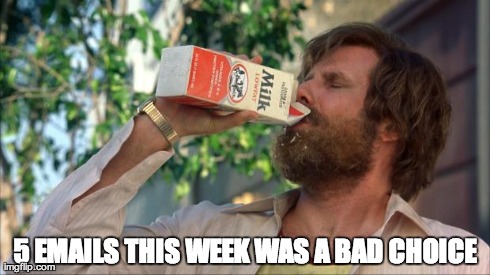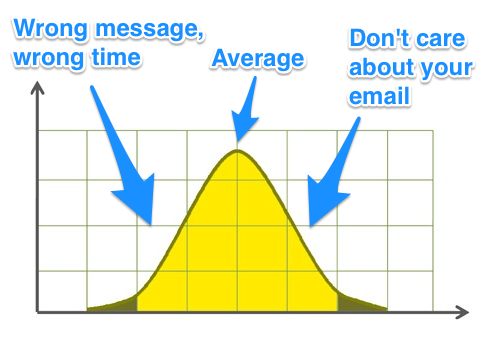How Email Marketers Can Thrive While Respecting “Inbox Zero”
-
UncategorizedUpdatedPosted:
On this page
Inbox zero.
It’s an achievement celebrated by everyone on Earth, except email marketers.
Here’s the thing about inbox zero though: It’s a real issue for people. Even email marketers get too much email. The collective response from email users – all 2.4 billion of them – has been overwhelming. McKinsey & Company reported that workers spend “28 percent of the workweek managing e-mail.” That works out to just over 11 hours … more than an entire day of the week
Quartz reported that it’s taking people longer to respond to emails too, mostly because they are getting so many.
On current trends, then, if email response times keep increasing by 10% a year, and assuming that an average postal delivery time in your country is two days, I estimate that by approximately 2020 it will be faster to get an answer from someone by writing a letter than by sending an email.
Workers also complain that email is a major cause of stress. Tom Jackson, a professor at Loughborough University, conducted a study of government workers in the UK. He found that email caused stress for 92 percent of the people studied.
The findings showed a direct link between email and stress – and indicated that employees are more prone to increased stress when reading and sending emails.
For example, the majority of participants – 92 percent – became fraught, with many recording elevated blood pressure and heart rate readings, during email and phone use.
More than a few startups are aiming to kill or transform email. Here are just a few:
To summarize the current email landscape, people are just sick of getting so much freaking email. We, the email marketing community, are partially to blame for this.
How can we fix this?
I have a few ideas. Let me know what you think in the comments.
1. Send responsibly.

It’s the first and most obvious rule of email marketing but it’s also the most abused. Not only should you limit the frequency of your emails, you should spend more time segmenting lists and sending data-driven behavioral emails rather than “blasts”.
Don’t take Ron Burgundy’s word for it though, there is good data supporting the case for sending fewer emails. We analyzed more than 100 million emails send by Vero users and found that frequency has a significant impact on click rates.
In fact, the third email of the week saw a 37 percent drop in click rates. That’s a huge number and sure sign that people are tired of getting your emails.
2. Stop targeting the ‘average’ subscriber.
When you send a “blast” or “bulk” email, you are targeting the “average” user. Let’s spend a minute talking about the word “average”. It’s a math term that refers to the sum of a series of numbers divided by the number of inputs.
So if you have the numbers 4, 17, 41, 65, 83 and 96, the average is 51. The number 51 doesn’t appear anywhere in the list, but it is the average of those six numbers.
How does this apply to email marketing?
Let’s say you have 10,000 people on your email marketing list. If you are lucky, 20 percent of them will open an email. The other 80 percent don’t care enough to even open it. That’s because it’s the wrong message at the wrong time for the wrong person. So few people on your list are “average” that you are essentially targeting no one.

The alternative to this is personalization, which is taking on a new meaning. Instead of just adding <First.name> to the beginning of every email, start thinking about how you can send one-to-one emails. In other words, how can you send every person on your list the right message at the right time?
It’s easier than you think thanks to behavioral email. By tracking events on your site, you can trigger emails based on interest, context and activity. Instead of blasting the same coupon to all 10,000 people, you can send a positive testimonial about a specific product to people who viewed that product page twice this week. This is the kind of email that has helped grow massive businesses like Amazon, Airbnb, Target and others. And even more exciting, it’s affordable and accessible to just about anyone.
3. Don’t put all your eggs in one basket.

One of the main reasons that social media has become so popular is because it’s NOT email. The mechanism of Facebook, Twitter, Instagram and email is largely the same. The goal is simply to send text and media to people. Now that we have different mediums to accomplish this, it’s smart not to put all your eggs in one basket by focusing all of your energy and budget on email.
At Vero, we spend the bulk of our marketing time on content. Email is one of many ways we acquire traffic for that content but Twitter, Facebook, forums, communities and SEO have all been important too. In addition, we separate time spent on newsletters and promotional email with time spent on drip campaigns, onboarding emails, transactional emails and behavioral email.
It’s worth looking at where your best customers come from and applying the Pareto principle, also known as the 80/20 rule. The Pareto principle states that 80 percent of the effects come from 20 percent of the causes. It’s been used in business development and personal productivity enhancement for years.
The Pareto Principle, or “80/20 Rule” as it is frequently called today, is an incredible tool for growing your business. For instance, if you can figure out which 20% of your time produces 80% of your business’ results, you can spend more time on those activities and less time on others. Likewise, by identifying the characteristics of the top 20% of your customers (who represent 80% of your sales), you can find more customers like them and dramatically grow your sales and profits.
If your best customers come from Twitter, spend more time there. If the best ones come from email, spend more time with email. Whatever you do, leverage multiple platforms and experiment with different content and calls to action to ensure you aren’t spending too much time with any single strategy.
4. Live the Golden Rule.
“Email others as you would have them email you.”
You might think I’m being cute … but I’m not. This the the single best way to avoid contributing to global email abuse. If you wouldn’t be happy to receive the email you are considering sending, don’t send it. It’s as simple as that.
Have any ideas to add? Let us know in the comments.
Want to send more personalized mobile and email messages to your users?
Learn moreCustomer story

How Vero helps Plann cater to the needs of an agile startup that's scaling up quickly

